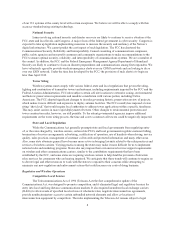Sprint - Nextel 2008 Annual Report Download - page 19
Download and view the complete annual report
Please find page 19 of the 2008 Sprint - Nextel annual report below. You can navigate through the pages in the report by either clicking on the pages listed below, or by using the keyword search tool below to find specific information within the annual report.Consolidation and competition in the wholesale market for wireline services, as well as consolidation of our
roaming partners and access providers used for wireless services, could adversely affect our revenues and
profitability.
Our Wireline segment competes with AT&T, Verizon, Qwest Communications, Level 3
Communications Inc., other major local incumbent operating companies, and cable operators, as well as a host of
smaller competitors, in the provision of wireline services. Some of these companies have high-capacity, IP-based
fiber-optic networks capable of supporting large amounts of voice and data traffic. Some of these companies
claim certain cost structure advantages that, among other factors, may allow them to offer services at a price
below that which we can offer profitably. In addition, consolidation by these companies could lead to fewer
companies controlling access to more cell sites, enabling them to control usage and rates, which could negatively
affect our revenues and profitability.
We provide wholesale services under long term contracts to cable television operators which enable
these operators to provide consumer and business digital telephone services. These contracts may not be renewed
as they expire, generally in the time period between 2011 and 2013.
Increased competition and the significant increase in capacity resulting from new technologies and
networks may drive already low prices down further. AT&T and Verizon continue to be our two largest
competitors in the domestic long distance communications market. We and other long distance carriers depend
heavily on local access facilities obtained from ILECs to serve our long distance subscribers, and payments to
ILECs for these facilities are a significant cost of service for our Wireline segment. The long distance operations
of AT&T and Verizon have cost and operational advantages with respect to these access facilities because those
carriers serve significant geographic areas, including many large urban areas, as the incumbent local carrier.
In addition, our Wireless segment could be adversely affected by changes in rates and access fees that
result from consolidation of our roaming partners and access providers, which could negatively affect our
revenues and profitability.
Failure to complete development, testing and deployment of new technology that supports new services could
affect our ability to compete in the industry. The deployment of new technology and new service offerings
could result in network degradation or the loss of subscribers. In addition, the technology we use may place us
at a competitive disadvantage.
We develop, test and deploy various new technologies and support systems intended to enhance our
competitiveness by both supporting new services and features and reducing the costs associated with providing
those services. Successful development and implementation of technology upgrades depend, in part, on the
willingness of third parties to develop new applications in a timely manner. We may not successfully complete
the development and rollout of new technology and related features or services in a timely manner, and they may
not be widely accepted by our subscribers or may not be profitable, in which case we could not recover our
investment in the technology. Deployment of technology supporting new service offerings may also adversely
affect the performance or reliability of our networks with respect to both the new and existing services and may
require us to take action like curtailing new subscribers in certain markets. Any resulting subscriber
dissatisfaction could affect our ability to retain subscribers and have an adverse effect on our results of operations
and growth prospects.
Our wireless networks provide services utilizing CDMA and iDEN technologies. Wireless subscribers
served by these two technologies represent a smaller portion of global wireless subscribers than the subscribers
served by wireless networks that utilize Global System for Mobile Communications (GSM) technology. As a
result, our costs with respect to both CDMA and iDEN network equipment and devices may continue to be
higher than the comparable costs incurred by our competitors who use GSM technology, which places us at a
competitive disadvantage.
We entered into agreements in 2008 with Clearwire to integrate our former 4G wireless broadband
business with theirs. See “Risks Related to our Investment in Clearwire” below for risks related to our investment
in Clearwire and the deployment of 4G.
17
























